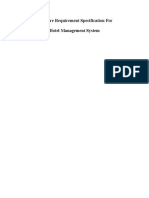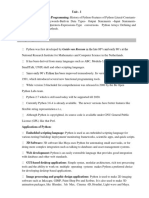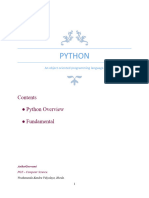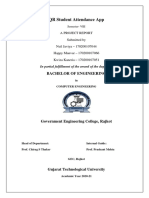Python
Uploaded by
prakriti.2226cse1190Python
Uploaded by
prakriti.2226cse1190Python
Introduction Python features
Python is a popular programming language. Easy-to-learn: Python is clearly defined and easily readable. The structure
It was created by Guido van Rossum, and released in 1991. of the program is very simple. It uses few keywords (predefined words in
It is case sensitive i.e. it treats upper and lower case differently. Python).
Python is a general-purpose interpreted, interactive, object-oriented, and Eg:
high-level programming language. When to write “Hello world!”
o Python is interpreted: Python is processed at runtime by the In C language, then code is:
interpreter. It does not need compilation time before execution.
o Python is Interactive: It is easy to learn Python as programmer can
directly interact with the interpreter directly to write your programs.
o Python is Object-Oriented: Python supports Object-Oriented style
or technique of programming that encapsulates code within objects.
o Python is a Beginner's Language: Python is a great language for In Python language is;
the beginner Level programmers and supports the development of a
wide range of applications.
Easy-to-maintain: Python's source code is fairly easy-to-maintain.
Python program cycle Portable: Python can run on a wide variety of hardware platforms and has
the same interface on all platforms.
Interpreted: Python is processed at runtime by the interpreter. So, there is
no need to compile a program before executing it. You can simply run the
program.
Extensible: Programmers can embed python within their C,C+
+,JavaScript , ActiveX, etc.
Free and Open Source: Anyone can freely distribute it, read the source
code, and edit it.
High Level Language: When writing programs, programmers concentrate
on solutions of the current problem, no need to worry about the low level
details.
Scalable: Python provides a better structure and support for large programs
than shell scripting.
Application of Python 3. Literals
Literals are data items that have fixed/constant values
web development (server-side),
software development,
mathematics,
system scripting.
Tokens in Python
The smallest individual unit in a program is known as Token or lexical unit.
Python tokens are:
o Keywords
o Identifiers
o Literals
o Operators
o Punctuators
1. Keywords in Python
These are predefined words with special meaning to the language
compiler or interpreter.
These are reserved for speacis=al purpose and must not be used as
normal identifier names.
Eg: False, True, del, None, class, in, or, and, etc.
2. Identifiers in Python
Identifiers are the names given to different parts of the program
viz. variables, object, classes, functions, lists, dictionaries and so
forth.
The naming rules for Python identifiers can be as follows:
Names must only be non- keyword word
There should not be any space
Name must contain number, alphabets, and underscore (_)
It cannot begin with number but con contain number
Verified identifiers Invalid Identifiers
Myfile, DATE_7, DATA-REC, 29clct, break,
MYFILE, etc etc
You might also like
- APznzaaycw TsI Ksr UwvtYb807ayuqjlZ GCFtH1XSONvBngW6DrKGe3yLLsqDGd9o 8U9OMe COF C490y 44dtOBH 53h6NwHltR5OAZgVNns8UNp TmCr OewKKX0UsOCenzeYWn0SpjKC1P8Nz8asTUl8tCw1bcW2PeV2IKl9qsdeWTf59tasEvTORq2ziWW s4diMGGVVYPu rNo ratings yetAPznzaaycw TsI Ksr UwvtYb807ayuqjlZ GCFtH1XSONvBngW6DrKGe3yLLsqDGd9o 8U9OMe COF C490y 44dtOBH 53h6NwHltR5OAZgVNns8UNp TmCr OewKKX0UsOCenzeYWn0SpjKC1P8Nz8asTUl8tCw1bcW2PeV2IKl9qsdeWTf59tasEvTORq2ziWW s4diMGGVVYPu r39 pages
- Chapter - 1 - Python Overview and FundamentalsNo ratings yetChapter - 1 - Python Overview and Fundamentals14 pages
- Chapter-5 XIC CS Python Introduction (1)No ratings yetChapter-5 XIC CS Python Introduction (1)78 pages
- The Best Python Programming Step-By-Step Beginners Guide Easily Master Software engineering with Machine Learning, Data Structures, Syntax, Django Object-Oriented Programming, and AI applicationFrom EverandThe Best Python Programming Step-By-Step Beginners Guide Easily Master Software engineering with Machine Learning, Data Structures, Syntax, Django Object-Oriented Programming, and AI applicationNo ratings yet
- Webcrawl A Blog To Retrieve All Entries LocallyNo ratings yetWebcrawl A Blog To Retrieve All Entries Locally42 pages
- Performance Testing With JMeter Second Edition - Sample Chapter0% (1)Performance Testing With JMeter Second Edition - Sample Chapter20 pages
- Marking Scheme Computer Science - DelhiNo ratings yetMarking Scheme Computer Science - Delhi41 pages
- Application Development Practices: Analyzing and Fixing DefectsNo ratings yetApplication Development Practices: Analyzing and Fixing Defects24 pages
- What Is A Defect Life Cycle or A Bug Lifecycle in Software Testing?No ratings yetWhat Is A Defect Life Cycle or A Bug Lifecycle in Software Testing?2 pages
- Python Practical Questions For HND PearsonNo ratings yetPython Practical Questions For HND Pearson7 pages
- Mychaela Falconia (She/her) 760-787-0545: Core Skill AreasNo ratings yetMychaela Falconia (She/her) 760-787-0545: Core Skill Areas5 pages
- Lessons Learned, Xclass Import With Thumbnail Images, ForumNo ratings yetLessons Learned, Xclass Import With Thumbnail Images, Forum5 pages
- QR Student Attendance App: Bachelor of EngineeringNo ratings yetQR Student Attendance App: Bachelor of Engineering42 pages
- HTML and JavaScript BASICS 4th Edition Barksdale Test Bank instant download100% (5)HTML and JavaScript BASICS 4th Edition Barksdale Test Bank instant download38 pages
- IT PROF 4 - Mobile Application DevelopmentNo ratings yetIT PROF 4 - Mobile Application Development1 page
- Object Oriented Programming Languages And Eventdriven Programming Dorian P Yeager instant download100% (1)Object Oriented Programming Languages And Eventdriven Programming Dorian P Yeager instant download82 pages
- System Administration and Maintenance Midterm Exam Attempt Review PDFNo ratings yetSystem Administration and Maintenance Midterm Exam Attempt Review PDF2 pages

























































































